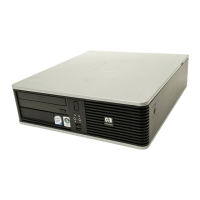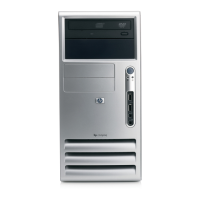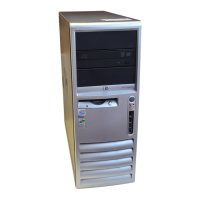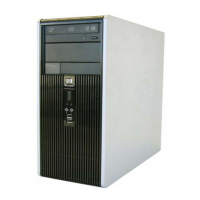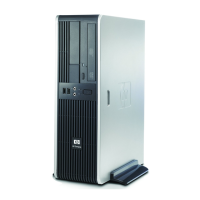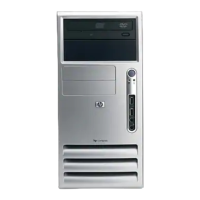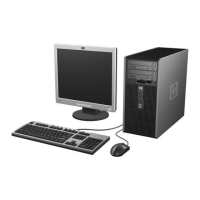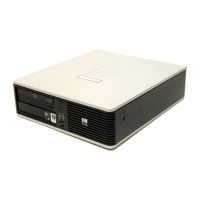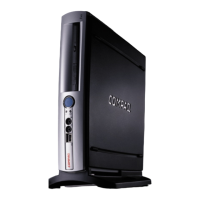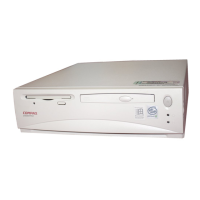Do you have a question about the Compaq dc7900 - Convertible Minitower PC and is the answer not in the manual?
Overview of the Computer Setup (F10) Utility and its primary functions.
Manage system files and settings, including saving/restoring configuration and updating BIOS.
Configure storage devices, diskette types, drive emulation, and translation modes.
Manage system security features like passwords, device access, and network boot.
Control power management features, including OS power management and thermal settings.
Configure advanced system settings for power-on, onboard devices, and system IDs.
View system details such as product name, SKU, processor, memory, and BIOS version.
Displays copyright notice and other document-related information.
Allows you to set the system's current time and date.
Update the system ROM with a BIOS image file from a USB flash drive or CD-ROM.
Save system configuration to removable media or restore it from removable media.
Save current settings as default or restore factory default settings.
Apply defaults, ignore changes, or save changes and exit Computer Setup.
Lists installed BIOS-controlled storage devices and options like Diskette Type and Drive Emulation.
Identifies the highest capacity media type accepted by the diskette drive.
Select drive emulation type for storage devices like ATAPI Zip drives.
Specifies sectors transferred per multi-sector PIO operation for ATA disks.
Selects translation mode for ATA disks to access partitioned/formatted disks on other systems.
Appears when User translation mode is selected for ATA disks.
Specifies parameters for BIOS to translate disk I/O requests for hard drives.
Sets default values for Multisector Transfers, Transfer Mode, and Translation Mode for ATA devices.
Enables/disables the ability to boot the system from removable media.
Enables/disables ability to write data to legacy diskettes.
Choose how the SATA controller and devices are accessed by the OS (IDE, RAID, AHCI).
Choose maximum eSATA speed (1.5 Gbps or 3.0 Gbps).
Execute self-tests on ATA hard drives capable of performing the Drive Protection System (DPS).
Specify the order devices are checked for a bootable operating system.
Set and enable a setup (administrator) password to control access to Computer Setup options.
Set and enable a power-on password that prompts before system boot.
Configure password-related options like locking resources or enabling network server mode.
Lock/unlock the cover lock and set the cover removal sensor.
Set availability for various ports and devices like Serial, Parallel, SATA, USB.
Set availability for Front and Rear USB Ports.
Enable/disable booting from an operating system installed on a network server.
Set Asset tag, Ownership tag, and Chassis serial number/UUID.
Assign or modify master/user passwords for hard drives.
Includes Data Execution Prevention, PAVP, Virtualization Technology, and Trusted Execution Technology.
Provides limited end-user access to change specific setup options without knowing the Setup Password.
Manage runtime power, idle power savings, and sleep state blink rates.
SATA power management enables or disables SATA bus and/or device power management.
Controls the minimum permitted fan speed for thermal management.
Set POST mode, POST messages, and prompts for F9, F10, F11, F12, and Recovery.
Enables an F11 prompt for HP Backup and Recovery during POST.
Causes the system to display a message before loading option ROMs.
Causes the system to power up momentarily after a power loss to enable Wake On LAN.
Specifies the source for remote wakeup: remote server or local hard drive.
Configures computer behavior after power restoration: Off, On, or Previous state.
Restarts the computer and executes the POST memory test.
Allows setting the computer to turn on automatically at a specified time.
Configure or disable onboard devices like diskette, serial, and parallel ports.
Lists PCI devices and allows reconfiguring IRQ settings or disabling them.
Specify the primary VGA controller when multiple PCI video adapters are present.
Enable/disable PCI SERR# Generation and PCI VGA palette snooping.
Set printer mode, Num Lock state, S5 Wake on LAN, and processor cache.
Configure integrated video and PCI Up Solution video simultaneously.
Disable multi-processor support under the OS.
Enable or disable the internal speaker.
Save monitor asset information.
Disable NIC option ROM to free up DCH space for PCI cards.
Select BIOS management operations through embedded solution or installed NIC cards.
Configure MEBx Setup Prompt, Remote Help, Connection Timeout, and SOL options.
Save configuration to removable media before restoring it.
Overview of the Computer Setup (F10) Utility and its primary functions.
Manage system files and settings, including saving/restoring configuration and updating BIOS.
Configure storage devices, diskette types, drive emulation, and translation modes.
Manage system security features like passwords, device access, and network boot.
Control power management features, including OS power management and thermal settings.
Configure advanced system settings for power-on, onboard devices, and system IDs.
View system details such as product name, SKU, processor, memory, and BIOS version.
Displays copyright notice and other document-related information.
Allows you to set the system's current time and date.
Update the system ROM with a BIOS image file from a USB flash drive or CD-ROM.
Save system configuration to removable media or restore it from removable media.
Save current settings as default or restore factory default settings.
Apply defaults, ignore changes, or save changes and exit Computer Setup.
Lists installed BIOS-controlled storage devices and options like Diskette Type and Drive Emulation.
Identifies the highest capacity media type accepted by the diskette drive.
Select drive emulation type for storage devices like ATAPI Zip drives.
Specifies sectors transferred per multi-sector PIO operation for ATA disks.
Selects translation mode for ATA disks to access partitioned/formatted disks on other systems.
Appears when User translation mode is selected for ATA disks.
Specifies parameters for BIOS to translate disk I/O requests for hard drives.
Sets default values for Multisector Transfers, Transfer Mode, and Translation Mode for ATA devices.
Enables/disables the ability to boot the system from removable media.
Enables/disables ability to write data to legacy diskettes.
Choose how the SATA controller and devices are accessed by the OS (IDE, RAID, AHCI).
Choose maximum eSATA speed (1.5 Gbps or 3.0 Gbps).
Execute self-tests on ATA hard drives capable of performing the Drive Protection System (DPS).
Specify the order devices are checked for a bootable operating system.
Set and enable a setup (administrator) password to control access to Computer Setup options.
Set and enable a power-on password that prompts before system boot.
Configure password-related options like locking resources or enabling network server mode.
Lock/unlock the cover lock and set the cover removal sensor.
Set availability for various ports and devices like Serial, Parallel, SATA, USB.
Set availability for Front and Rear USB Ports.
Enable/disable booting from an operating system installed on a network server.
Set Asset tag, Ownership tag, and Chassis serial number/UUID.
Assign or modify master/user passwords for hard drives.
Includes Data Execution Prevention, PAVP, Virtualization Technology, and Trusted Execution Technology.
Provides limited end-user access to change specific setup options without knowing the Setup Password.
Manage runtime power, idle power savings, and sleep state blink rates.
SATA power management enables or disables SATA bus and/or device power management.
Controls the minimum permitted fan speed for thermal management.
Set POST mode, POST messages, and prompts for F9, F10, F11, F12, and Recovery.
Enables an F11 prompt for HP Backup and Recovery during POST.
Causes the system to display a message before loading option ROMs.
Causes the system to power up momentarily after a power loss to enable Wake On LAN.
Specifies the source for remote wakeup: remote server or local hard drive.
Configures computer behavior after power restoration: Off, On, or Previous state.
Restarts the computer and executes the POST memory test.
Allows setting the computer to turn on automatically at a specified time.
Configure or disable onboard devices like diskette, serial, and parallel ports.
Lists PCI devices and allows reconfiguring IRQ settings or disabling them.
Specify the primary VGA controller when multiple PCI video adapters are present.
Enable/disable PCI SERR# Generation and PCI VGA palette snooping.
Set printer mode, Num Lock state, S5 Wake on LAN, and processor cache.
Configure integrated video and PCI Up Solution video simultaneously.
Disable multi-processor support under the OS.
Enable or disable the internal speaker.
Save monitor asset information.
Disable NIC option ROM to free up DCH space for PCI cards.
Select BIOS management operations through embedded solution or installed NIC cards.
Configure MEBx Setup Prompt, Remote Help, Connection Timeout, and SOL options.
Save configuration to removable media before restoring it.
| Chipset | Intel Q45 Express |
|---|---|
| Memory | Up to 16 GB DDR2 SDRAM |
| Form Factor | Convertible Minitower |
| Audio | Integrated High Definition audio |
| Processor | Intel Core 2 Duo, Intel Core 2 Quad, or Intel Pentium Dual-Core |
| Storage | SATA Hard Disk Drive or Solid State Drive |
| Graphics | Intel GMA 4500 |
| Optical Drive | DVD-ROM, DVD+/-RW |
| Operating System | Windows Vista Business, Windows XP Professional |
| Networking | Integrated Intel Gigabit Network Connection |
| Ports | USB 2.0, VGA, DisplayPort |
| Power Supply | 365W |
| Expansion Slots | 1 PCIe x16 |
